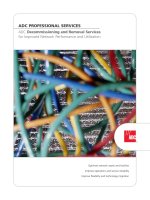Sensors and Wireless Communication for Medical Care
Bạn đang xem bản rút gọn của tài liệu. Xem và tải ngay bản đầy đủ của tài liệu tại đây (49.2 KB, 9 trang )
Sensors and Wireless
Communication for Medical Care
Anu Bhargava and Michael Zoltowski
CERIAS and ECE Department
Purdue University
West Lafayette, IN 47907
Presented by Anu Bhargava
This research is supported by CERIAS security center and NSF REU grant of Prof. Arif Ghafoor and Mike Zoltowski.
Security and Safety
Medical care environments are vulnerable to malicious behavior,
hostile setting, terrorism attacks, natural disaster, tampering.
Computing nodes and sensors can be malicious, selfish,
malfunctioning, or compromised.
Challenge is to develop sensors that detect and monitor violations in
medical care environments before threat to life occurs.
Reliability, Security, Accuracy can affect timeliness and precise
information for patient monitoring.
Collaboration among physicians/nurses, pharmacies, emergency
personnel, law enforcement agencies, government/community
leaders over wireless network should be secure, private, reliable,
consistent/correct and anonymous.
Slide 2
Technology and Type of Sensors
Sensors and wireless devices have limited computation, communication, and energy.
High rate of temporary or lasting failure.
Tiny, inexpensive, mobile sensors are becoming available.
Microsensors consist of 8-bit 4-MHz processors.
Bio-sensors to detect Anthrax, viruses, toxins, bacteria uses chips coated with
antibodies that attract a specific biological agent. Pattern changes result in alerts.
Ion trap mass spectrometer aids in locating fingerprints of proteins to detect toxin or
bacteria.
Neutron-based detectors detect chemical and nuclear materials.
Research is underway on sensor fusion, topology management, smart dust,
scalability, and wireless communication issues.
Characteristics of sensors include size, battery consumption, energy level,
movement, position, redundancy, failure mode (failed, degrading, Byzantine).
Slide 3
Research Issues
Smart Antennae
Omni-directional antenna has a problem with congestion and
eavesdropping. One solution is smart antennae with multiple sub-antennae
and switches (sectorized, phase array, and adaptive array).
Sectorized has elements that aim in different directions and only one sector
is energized with Radio Frequency.
Phase-array can steer a main lobe in any direction, but not capable of
forming nulls.
Adaptive-arrays can form multiple main lobes and steerable nulls in the
direction of interferes.
Jam Resistant Antennae
Two antennae on each device and use polarization in a way to receive
signals from one direction. Channel estimation possible when distinct
antennae have different polarization or significant spatial separation.
Slide 4
Fault-tolerant Authentication
o If base station fails, use backup controller in the immediate neighborhood.
o Hierarchy of base stations with multiple keys can be used.
Denial of Service Attacks and Intruder Identification
o Flooding by a malicious host, impersonation, gang attack, Byzantine behavior.
o Suspicion lists, black list can be created to ignore sensors.
Privacy and Anonymity
o Location of sensor.
o Source of data.
o False accusation.
o HIPPA regulations for medical data.
o Limited access and disclosure.
Energy Conservation
o Aggregation of data and pattern identification.
o Routers need to be computationally efficient for energy.
Slide 5
Sensors in a Patient’s Environment
Safety and Security in Patient’s Room
o Monitor the entrance and access to a patient’s room.
o Monitor pattern of activity with respect to devices connected to a patient.
o Protect patients from neglect, abuse, harm, tampering, movement of patient outside
the safety zone.
o Monitor visitor clothing to guarantee hygiene and prevention of infections.
Safety and Security of the Hospital
o Monitor temperature, humidity, air quality.
o Identify obstacles for mobile stretchers.
o Protect access to FDA controlled products, narcotics, and special drugs.
o Monitor tampering with medicine, fraud in prescriptions.
o Protect against electromagnetic attacks, power outages, and discharge of biological
agent.
Slide 6
Privacy and Security of Network and
Computer Systems
Privacy of patient record and identification.
Protect against changes to patient records or treatment plan.
Protect against disabling monitoring devices, switching off/crashing
computers, flawed software, disabling messages.
QoS issues for multimedia data
Vulnerabilities of wireless communication protocols such as 802.11
and bluetooth. Decrypting traffic, injection of new traffic, attacks
from jamming devices.
Slide 7
Measures of Safety and Security
Number of incidents per day in patient room, ward, or
hospital.
Non-emergency calls to nurses and doctors due to
malfunctions, failures, or intrusions.
False fire alarms, smoke detectors, pagers activation.
Wrong information, data values, lost or delayed
messages.
Timeliness, Accuracy, Precision.
Slide 8
Conclusion
Use of sensors can increase safety and security.
But can be used by terrorists to kill all electronic,
disrupt or destroy digital devices, and control
information flow.
Slide 9









